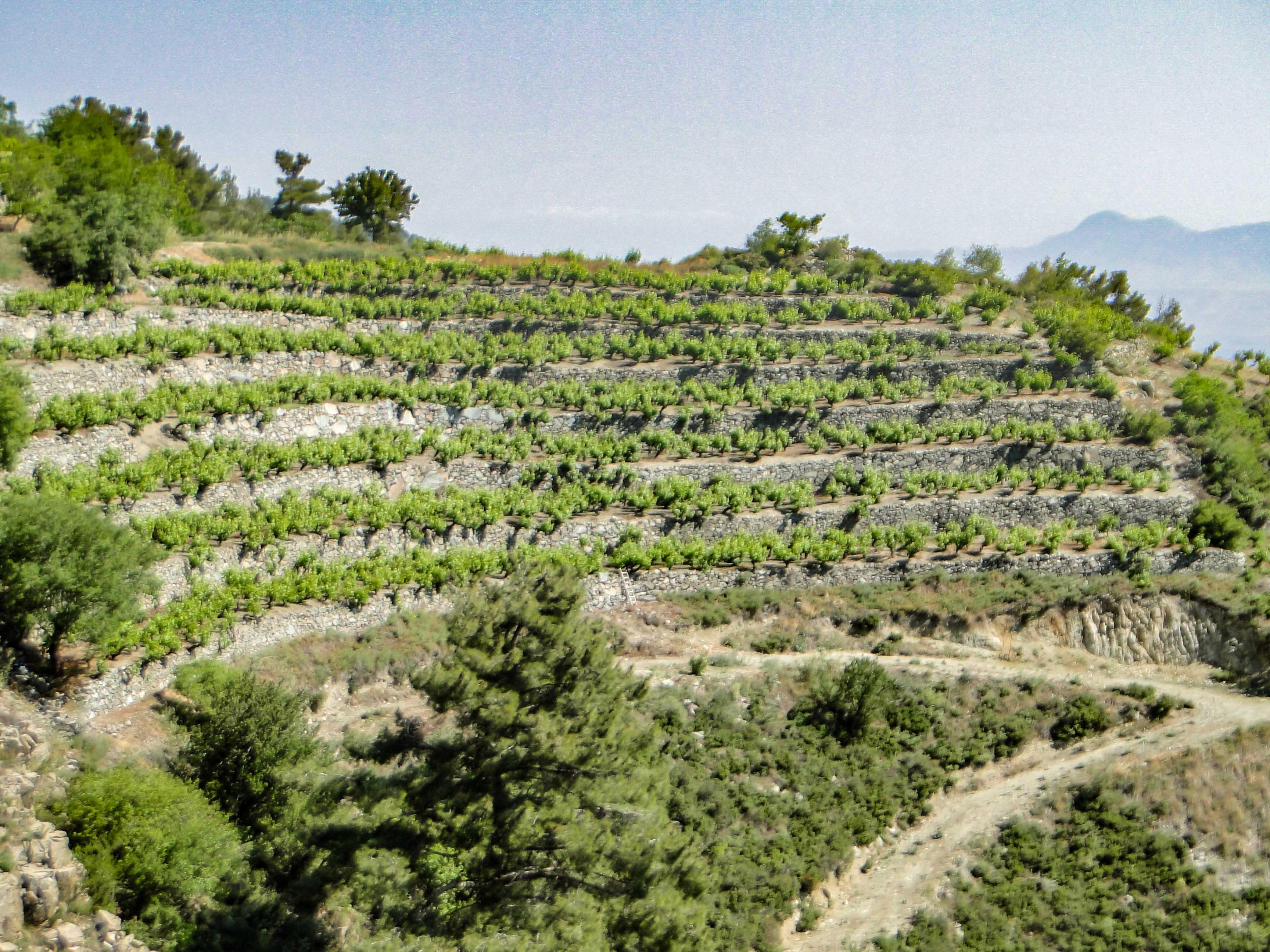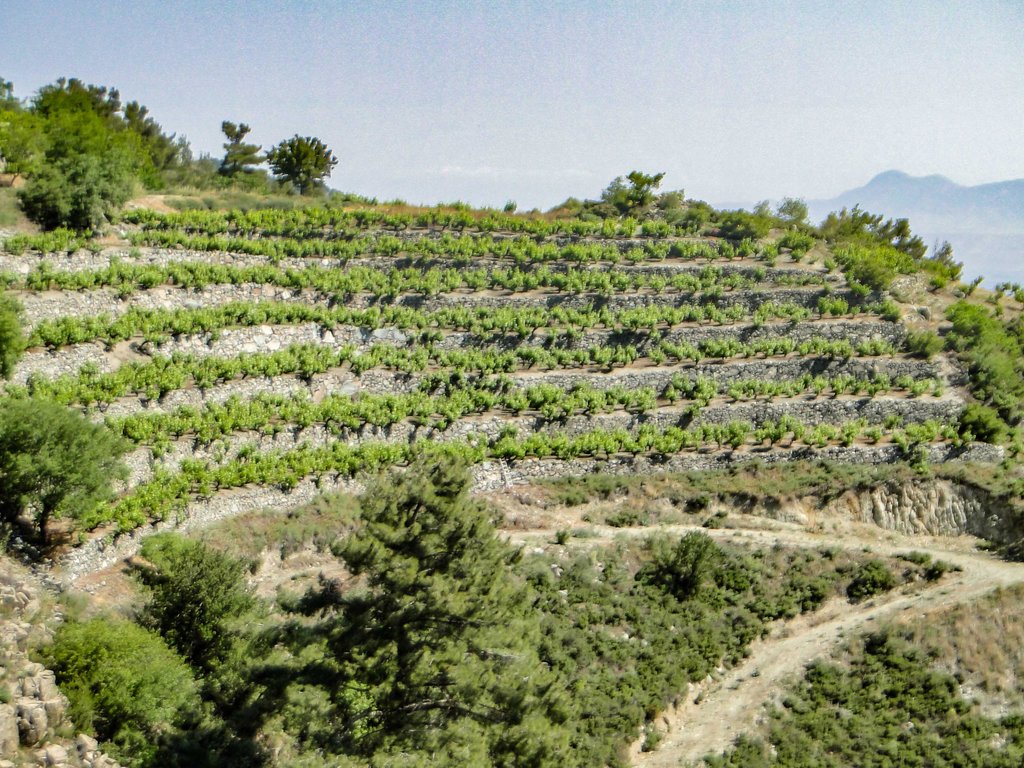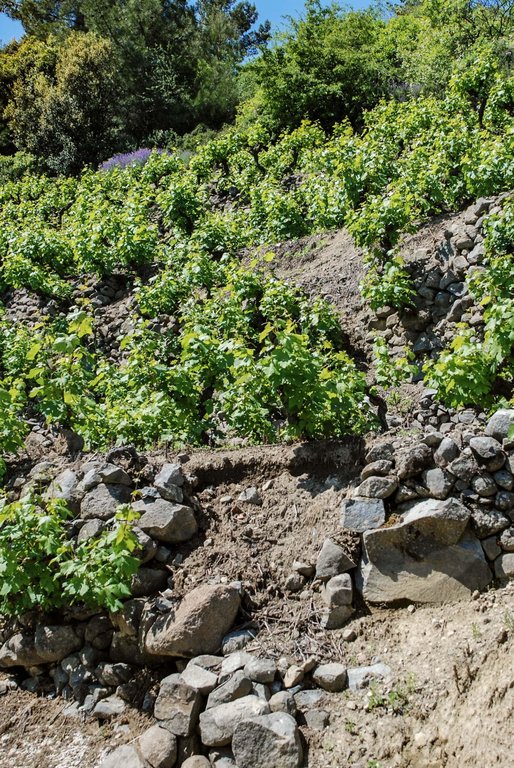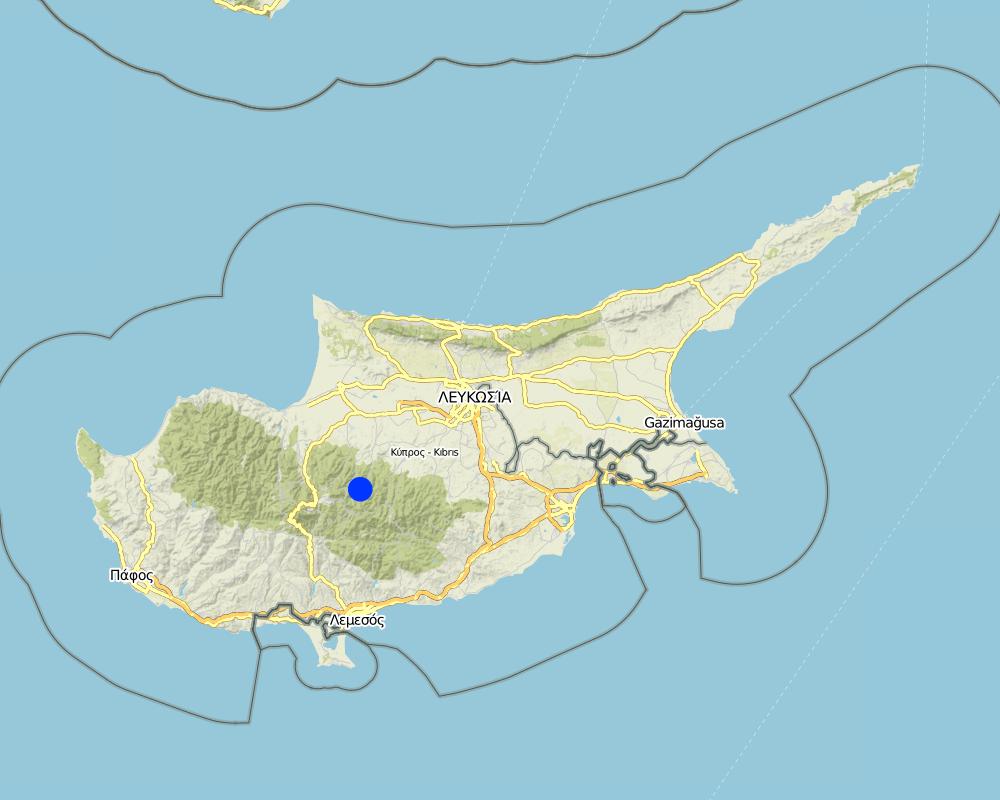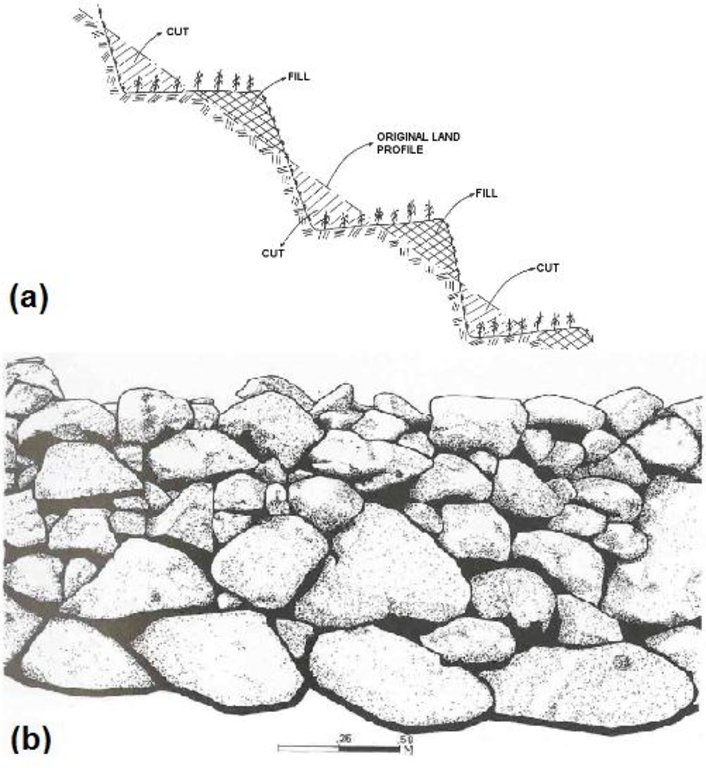Agricultural terraces with dry-stone walls [Кипр]
- Шинийг нээх:
- Шинэчлэх:
- Мэдээлэл цуглуулсан: Christos Zoumides
- Редактор: –
- Хянагчид: Deborah Niggli, Alexandra Gavilano
Γεωργικές αναβαθμίδες με τοίχους ξερολιθιάς (Greek)
technologies_1702 - Кипр
Бүлгүүдийг үзэх
Бүгдийг харуулах Бүгдийг хаах1. Ерөнхий мэдээлэл
1.2 Технологийг үнэлэх, баримтжуулах ажилд хамаарах мэдээлэл өгсөн хүмүүс, байгууллагуудын холбоо барих мэдээлэл
ГТМ мэргэжилтэн :
Bruggeman Adriana
The Cyprus Institute
Кипр
ГТМ мэргэжилтэн :
Camera Corrado
The Cyprus Insitute
Кипр
Технологи баримтжуулах/үнэлэх ажилд дэмжлэг үзүүлсэн төслийн нэр (шаардлагатай бол)
Preventing and Remediating degradation of soils in Europe through Land Care (EU-RECARE )Технологи баримтжуулах/үнэлэх ажилд дэмжлэг үзүүлсэн байгууллага(ууд)-ын нэр (шаардлагатай бол)
The Cyprus Institute (The Cyprus Institute) - Кипр1.3 WOCAT-аар баримтжуулсан өгөгдлийг ашиглахтай холбоотой нөхцөл
Эмхэтгэгч болон гол мэдээлэгч хүн(хүмүүс) WOCAT аргачлалаар баримтжуулсан мэдээллийг ашиглахтай холбоотой нөхцлийг хүлээн зөвшөөрсөн.
Тийм
1.4 Технологи тогтвортой гэдгийг баталгаажуулах
Энэ технологи азрын доройтлыг бууруулахад нөлөө үзүүлэхгүй тул газрын тогтвортой менежментийн технологи болж чадахгүй юу?
Үгүй
1.5 ГТМ Арга барилын Асуулга (ууд) руу хандах (WOCAT ашиглан баримтжуулсан)
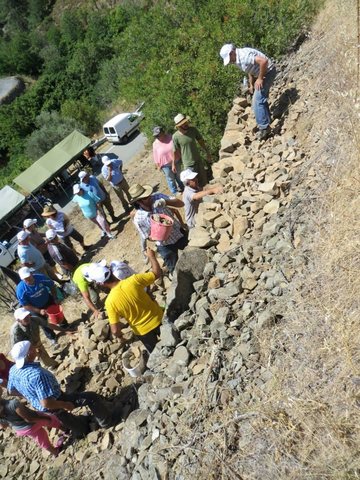
Community-based maintenance and rehabilitation of agricultural terraces in … [Кипр]
Maintenance and rehabilitation of traditional dry-stone terrace walls for agricultural use, through science-society cooperation, community engagement and motivation, and assistance to land users.
- Мэдээлэл цуглуулсан: Christos Zoumides
2. ГТМ Технологийн тодорхойлолт
2.1 Технологийн товч тодорхойлолт
Технологийн тодорхойлолт:
Dry-stone terraces built to create agricultural land, minimise soil erosion and retain soil moisture on steep mountain slopes.
2.2 Технологийн дэлгэрэнгүй тайлбар
Тодорхойлолт:
Dry-stone terraces consist of a series of nearly levelled platforms built along contour lines at suitable intervals. These structures characterise a large part of the landscape in Cyprus, and especially in communities around Troodos Mountains where large areas have been converted to agricultural terraces. The typical terraces found in the study-area are narrow (1-3 m) to medium-base (3-6 m) bench terraces, constructed by cutting and filling in slopes between 20-40%. The terraces are supported by walls, whereby stone is the only construction material without any binding mortar.
Terracing is one of the oldest means of cultivating slopes while saving soil and water. Due to the steep terrain of Troodos Mountains, the establishment of terraces acts as sediment trap storing the washed-off soil material within the slope. In general, terraces were created to stop or reduce the degrading effect of soil erosion by intercepting and controlling the surface run-off velocity and by facilitating its slower infiltration. In such a way, the sediment that accumulates behind the terraces has created suitable land for farming. In addition, the construction of dry-stone walls serves a dual purpose: to clear the land from large rock and stones, and to enhance the stability of the bench terraces against loss of top-soil. This is a type of technology that was very much used in the past and seen today as an important cultural landscape and heritage for these communities.
The construction of dry-stone walls was usually completed by the family who owned the field. Men undertook the building while the rest of the family carried the stones; assistance was also offered by relatives and friends of the family. First, the topography, the height and shape of the terrace is evaluated. Using a fuse, the craftsman shapes a straight line which would follow while building the wall. The foundations are created by excavating a pit of ~0.3-0.5 m, depending on the type of soils and the size of the wall; fuse, pick, mattock and shovel are the typical tools used. The pit is filled with large, irregular-shaped stones.
The stones are used in their natural shape for the construction of the walls without any processing. They are separated according to their shape, size and texture. The stones usually come from the cleaning of fields which will be cultivated or from a small-scale quarrying of the mountain slope using pick and lever. Large and irregular stones are used for the foundations, and the more regular ones for the construction of walls. The smaller stones are placed in between the large stones as the linchpin, to provide better stability to the structure.
The wall follows the land inclination and is laid over the foundation. Large stones are placed on the lower courses of the wall and on the exterior side. The stones are placed by hand one over the other, while smaller stones and rubbles are put between them in order to achieve more stability and better positioning; the stones cross both vertically and horizontally in order to avoid the creation of columns which will make the structure less stable. The wall is built lengthwise following the foundations and it reclines inwards; declination from the foundations does not exceed 5%. The back side of the wall is filled-up with more irregular stones which are not suitable to be placed on the front side. The filling connects the wall with the soil and stabilises the structure, and allows the drainage of water that is collected from the terrace and is discharged through the stones of the wall.
Terrace farming of grapes, nut and fruit trees, along with natural (mainly sclerophylous) vegetation constitute the predominant land uses in this area. The total population in the eight mountain communities of Peristerona Watershed has decreased by more than 50% over the past 30 years. The depopulation of mountain communities is associated with the urbanisation trends and the high farming costs which led to the gradual reduction of agricultural activities in the area. These socio-economic attributes form the main constraining factors for soil conservation. Thus, although terraces have a particularly beneficial effect in maintaining the productive capacity of soils in these communities, the significant changes in the socio-economic structure of the agricultural population over the last decades and the high maintenance and labour required, has led farmers to gradually abandon terrace farming. Consequently, many of the mountain terraces are no longer cultivated and dry stone walls are not maintained, causing sometimes a domino effect of collapsing terraces.
2.3 Технологийн гэрэл зураг
2.5 Энэ үнэлгээнд хамрагдсан технологийг хэрэгжүүлсэн улс орон / бүс нутаг / байршил
Улс :
Кипр
Улс/аймаг/сум:
Nicosia
Байршлын дэлгэрэнгүй тодорхойлолт:
Northeast Pitsilia
Технологи өргөн дэлгэрсэн эсхийг тодорхойл:
- газар дээр жигд тархсан
Технологи газар нутгийн хэмжээнд жигд тархсан бол түүний эзлэх талбайг тодорхойлно уу (км2-аар):
30.9
Хэрэв талбайн хэмжээ тодорхойгүй бол талбайн хэмжээг ойролцоогоор тодорхойлно уу.
- 10-100 км2
Тайлбар:
Total area covered by the SLM Technology is 30.9 km2.
Dry-stone terraces characterise a large part of the landscape in Cyprus, and especially in communities around Troodos Mountains. There is a large variety of dry-stone terraces on the island, according to the morphology of each area and the accessibility to raw materials. The information reported here refer to the mountain communities in Northeast Pitsilia and particularly to the Peristerona watershed upstream communities (RECARE project case-study site).
Map
×2.6 Хэрэгжих огноо
Байгуулсан тодорхой оныг мэдэхгүй бол баримжаа хугацааг тодорхойл:
- >50 жилийн өмнө (уламжлалт)
2.7 Технологийн танилцуулга
Технологийг хэрхэн нэвтрүүлснийг тодорхойл:
- Уламжлалт системийн хэсэг (> 50 жил)
Тайлбар (төслийн төрөл г.м.):
Dry-stone terracing has been practice for centuries in Cyprus and in the study area. The rehabilitation of dry-stone terraces through community-based activities has been introduced in 2015 by the RECARE project case-study team and the local communities.
3. ГТМ технологийн ангилал
3.1 Технологийн үндсэн зорилго (д)
- Газрын доройтлыг бууруулах, сэргийлэх, нөхөн сэргээх
3.2 Технологи хэвтрүүлсэн газрын одоогийн газар ашиглалтын хэлбэр(д)

Тариалангийн газар
- Мод, бут тариалах
Мод, бут тариалах - Таримлыг тодорхойлно уу:
- жимс, бусад
- усан үзэм
- модны самар (бразил самар, туулайн бөөр, хушга, бүйлс г.м.)
Нэг жил дэх ургамал ургах улирлын тоо:
- 1
Тодорхойлно уу:
Longest growing period in days: 240, Longest growing period from month to month: Mid March to early November (grapevines)
Тайлбар:
Major land use problems (compiler’s opinion): Soil erosion by water from degraded and collapsing dry-stone terraces.
Loss of productive capacity.
Major land use problems (land users’ perception): Gradual collapse of dry-stone walls.
Root rot and yield failure as a result of water-logging which is linked to poor drainage in terraced fields.
3.4 Усан хангамж
Технологи хэрэгжүүлсэн газрын усан хангамж:
- Байгалийн усалгаатай
3.5 Технологи ГТМ-ийн аль бүлэгт хамаарах
- Налуугийн хөндөлн огтлолын дагуух арга хэмжээ
3.6 Технологийг бүрдүүлэх ГТМ арга хэмжээ

Барилга байгууламжийн арга хэмжээ
- S1: Террас
Тайлбар:
Main measures: structural measures
3.7 Технологийн шийдвэрлэсэн газрын доройтлын үндсэн төрлүүд

Хөрс усаар эвдрэх
- Wt: Хөрсний гадаргын угаагдал
- Wo: Усны элэгдлийн дам нөлөө
Тайлбар:
Main type of degradation addressed: Wt: loss of topsoil / surface erosion
Secondary types of degradation addressed: Wo: offsite degradation effects
Main causes of degradation: other human induced causes (specify) (Gradual abandonment of mountain agriculture), other natural causes (avalanches, volcanic eruptions, mud flows, highly susceptible natural resources, extreme topography, etc.) specify (Steep mountain terrain)
Secondary causes of degradation: land tenure (Small, fractured agricultural plots), governance / institutional (Lack of institutions for terrace maintenance)
3.8 Газрын доройтлоос урьдчилан сэргийлэх, сааруулах ба нөхөн сэргээх
Газрын доройтолтой холбоотойгоор Технологи ямар зорилго тавьсан болохыг тодорхойл:
- Газрын доройтлоос урьдчилан сэргийлэх
- Хүчтэй доройтсон газрыг нөхөн сэргээх/ сайжруулах
4. Техникийн нөхцөл, хэрэгжилтийн үйл ажиллагаа, материал ба зардал
4.1 Технологийн техникийн зураг
Техник тодорхойлолт (техник зурагтай уялдана):
(a) The typical terraces found in the study-area are narrow (1-3 m) to medium-base (3-6 m) bench terraces, constructed by cutting and filling in slopes between 20-40%. The height of terraces range between 0.75 to 2 meters, depending on the steepness and the morphology of each slope.
(b) The terraces are supported by walls, whereby stone - typically volcanic rock - is the only construction material without any binding mortar. Large and irregular stones are used for the foundations, while the more regular for the construction of walls. The smaller stones are placed in between the large stones as the linchpin, to provide better stability to the structure. The wall is built lengthwise following the foundations and it reclines inwards; declination from the foundations does not exceed 5%. The back side of the wall is filled-up with more irregular stones which are not suitable to be placed on the front side. The filling connects the wall with the soil and stabilises the structure, and allows the drainage of water that is collected from the terrace and is discharged through the stones of the wall.
Northeast Pitsilia, Nicosia
Technical knowledge required for land users: moderate (To maintain dry-stone wall terraces)
Technical knowledge required for Dry-stone artisans (experts builders): high (To reconstruct collapsed terraces)
Main technical functions: reduction of slope angle, sediment retention / trapping, sediment harvesting
Secondary technical functions: increase of infiltration, increase / maintain water stored in soil
Terrace: bench level
Vertical interval between structures (m): 1-2
Spacing between structures (m): 1-15
Construction material (stone): Natural volcanic rock available on the sites (mostly gabbro & diabase)
Lateral gradient along the structure: 0-8%
Зохиогч:
a: FAO, 2000 & b: TPH, 2007
4.2 Материал болон зардалд хамаарах ерөнхий мэдээлэл
бусад/үндэсний мөнгөн нэгж (тодорхойл):
Euro
Хэрэв боломжтой бол үндэсний валютын Америк доллартай харьцах харьцааг бичнэ үү (тухайлбал, 1 ам.дол. = 79,9 Бразил реал): 1 ам.дол. =:
0.88
Хөлсний ажилчны нэг өрдийн ажлын хөлсийг тодорхойл:
72.97
4.3 Байгуулах үйл ажиллагаа
| Үйл ажиллагаа | Хугацаа (улирал) | |
|---|---|---|
| 1. | Land leveling and foundation | Early autumn or late spring |
| 2. | Collection and transfer of stones | Early autumn or late spring |
| 3. | Construction of stone-wall | Early autumn or late spring |
4.4 Байгуулалтад шаардагдах зардал ба материал
| Хөрөнгө оруулалтыг дурьдана уу | Хэмжих нэгж | Тоо хэмжээ | Нэгжийн өртөг | Материал бүрийн нийт өртөг | % газар ашиглачаас гарсан зардал | |
|---|---|---|---|---|---|---|
| Хөдөлмөр эрхлэлт | Labour | 4000.0 | 45.6 | 182400.0 | 100.0 | |
| Технологи бий болгох нийт үнэ өртөг | 182400.0 | |||||
| Технологи бий болгох нийт үнэ өртөг, ам.доллар | 207272.73 | |||||
Тайлбар:
Duration of establishment phase: 83 month(s)
4.5 Засвар үйлчилгээ / давтагдах үйл ажиллагаа
| Үйл ажиллагаа | Хугацаа/ давтамж | |
|---|---|---|
| 1. | Repairing collapsed walls | Early autumn (before onset of rains), only on collapsed walls |
4.6 Засвар үйлчилгээ / урсгал үйл ажиллагаанд шаардагдах зардал ба материал (жилээр)
| Хөрөнгө оруулалтыг дурьдана уу | Хэмжих нэгж | Тоо хэмжээ | Нэгжийн өртөг | Материал бүрийн нийт өртөг | % газар ашиглачаас гарсан зардал | |
|---|---|---|---|---|---|---|
| Хөдөлмөр эрхлэлт | Labour | 200.0 | 9.12 | 1824.0 | 100.0 | |
| Технологийг арчилах тордоход шаардагдах нийт үнэ өртөг | 1824.0 | |||||
| Технологи сайжруулах нийт үнэ өртөг, ам.доллар | 2072.73 | |||||
Тайлбар:
Machinery/ tools: Wedge, hammer, pick, hoe and bucket are the typical tools used for by stone builders for the construction and maintenance of dry-stone terraces.
The costs estimates are averages and were calculated for the length of terrace structures, i.e. per running meter of terrace walls. The average height of dry-stone walls is 1.5 meter and it takes approximately 5 hours/meter for a builder to fully construct it. This includes 1 hour/meter for land levelling and foundation, 1 hour/meter for the collection and transfer of the necessary stones and 3 hours/meter for building the wall. Stones are abundant in the area; builders do not charge for the stones but for the time required to collect and transfer. Also, each builder has its own tools (i.e. wedge, hammer, pick, hoe and bucket). Terrace builders charge 8 €/hour (or 9.12 $/hour). On average, there are approximately 4000 running meters of terrace walls per hectare. The above information is used to convert the construction cost per hectare.
Maintenance activities include reconstruction of the terrace walls, only in case of collapsing. The reconstruction takes 1 hour/meter. For the annual maintenance estimates, it is assumed that 200 out of 4000 meters of terrace walls per hectare (or 5%) will require maintenance. In other words, a newly constructed wall will be maintained once every 20 years, on average.
4.7 Зардалд нөлөөлж байгаа хамгийн чухал хүчин зүйл
Өртөг зардлыг тодорхойлох гол хүчин зүйлсийг дурьдана уу:
The principal input cost for the construction and maintenance of terraces is manual labour. There are only few dry-stone builders in the area.
5. Хүн, байгалийн хүрээлэн буй орчин
5.1 Уур амьсгал
Жилийн нийлбэр хур тундас
- <250 мм
- 251-500 мм
- 501-750 мм
- 751-1,000 мм
- 1,001-1,500 мм
- 1,501-2,000 мм
- 2,001-3,000 мм
- 3,001-4,000 мм
- > 4,000 мм
Хур тунадасны талаархи тодорхойлолт/ тайлбар:
500-750mm: Seasonal rainfall (October to May) - Peristerona watershed upstream
250-500mm: Seasonal rainfall (October to May) - Peristerona watershed downstream
Агро-уур амьсгалын бүс
- Хагас чийглэг
- Хагас хуурай
Thermal climate class: subtropics. Below 1000m a.s.l.
Thermal climate class: temperate. Above 1000m a.s.l.
5.2 Байрзүйн зураг
Дундаж налуу:
- Тэгш (0-2 %)
- Бага зэрэг хэвгий (3-5 %)
- Дунд зэрэг хэвгий (6-10 % )
- Долгиорхог (11-15 %)
- Толгодорхог (16-30 %)
- Эгц налуу (31-60 % )
- Огцом эгц налуу (>60 %)
Гадаргын хэлбэр:
- Тэгш өндөрлөг/тэгш тал
- Зоо, хяр
- Уулын энгэр, хажуу
- Ухаа, гүвээ, дов толгод
- Уулын бэл
- Хөндий, хоолой, нам хотос
Өндөршлийн бүс:
- 0-100 м д.т.д
- 101-500 м д.т.д
- 501-1,000 м д.т.д
- 1,001-1,500 м д.т.д
- 1,501-2,000 м д.т.д
- 2,001-2,500 м д.т.д
- 2,501-3,000 м д.т.д
- 3,001-4,000 м д.т.д
- > 4,000 м д.т.д
Технологи дараах асуудалд хандсан эсэхийг тодорхойл:
- шаардлагагүй
5.3 Хөрс
Хөрсний дундаж зузаан:
- Маш нимгэн (0-20 см)
- Нимгэн (21-50 см)
- Дунд зэрэг зузаан (51-80 см)
- Зузаан (81-120 cм)
- Маш зузаан (>120 cм)
Хөрсний бүтэц (өнгөн хөрс):
- Сийрэг/хөнгөн (элсэрхэг)
- Дунд зэрэг (шавранцар)
Өнгөн хөрсний органик нэгдэл:
- Дунд (1-3 % )
- Бага (<1 % )
5.4 Усны хүртээм ба чанар
Хөрсний усны гүн:
> 50 м
Гадаргын усны хүртээмж:
Дунд зэрэг
Усны чанар (цэвэрлээгүй):
Сайн чанарын ундны ус
5.5 Биологийн төрөл зүйл
Зүйлийн олон янз байдал:
- Дунд зэрэг
5.6 Технологи нэвтрүүлсэн газар ашиглагчидын онцлог шинж
Суурьшмал эсвэл нүүдлийн:
- Суурьшмал
Үйлдвэрлэлийн системийн зах зээлийн чиг баримжаа:
- холимог (амьжиргаа ба худалдаанд)
Фермээс гадуурх орлого:
- Нийт орлогын % 10-50 хувь
Чинээлэг байдлыг харьцангуй түвшин:
- Дундаж
Хувь хүн эсвэл бүлэг:
- Хувь хүн / өрх
Механикжилтын түвшин:
- Хүнд хүчир ажил
- Механикжсан / мотортой
Хүйс:
- Эмэгтэй
- Эрэгтэй
Газар ашиглагчдын бусад шаардлагатай шинж чанарыг тодорхойл:
Land users applying the Technology are mainly common / average land users
Population density: 10-50 persons/km2
Annual population growth: negative; 4%
100% of the land users are average wealthy.
Off-farm income specification: Farming is a part-time activity for most land users in the area.
5.7 Технологи нэвтрүүлэхэд газар ашиглагчийн ашигласан газрын дундаж талбай
- < 0.5 га
- 0.5-1 га
- 1-2 га
- 2-5 га
- 5-15 га
- 15-50 га
- 50-100 га
- 100-500 га
- 500-1,000 га
- 1,000-10,000 га
- > 10,000 га
Энэ нь жижиг, дунд, том оворт тооцогдох уу (орон нутгийн чиг баримжаагаар)?
- Бага-хэмжээний
Тайлбар:
The average for Cyprus is 3.4 ha/holding
5.8 Газар эзэмшил, газар ашиглах эрх, ус ашиглах эрх
Газар өмчлөл:
- Хувь хүн, цол эргэм бүхий
Газар ашиглах эрх:
- Хувь хүн
Тайлбар:
Agricultural land is privately owned
5.9 Дэд бүтэц, үйлчилгээний хүртээмж
эрүүл мэнд:
- Ядуу
- Дунд зэргийн
- Сайн
боловсрол:
- Ядуу
- Дунд зэргийн
- Сайн
техник дэмжлэг:
- Ядуу
- Дунд зэргийн
- Сайн
хөдөлмөр эрхлэлт (жишээ нь, ХАА-аас өөр):
- Ядуу
- Дунд зэргийн
- Сайн
зах зээл:
- Ядуу
- Дунд зэргийн
- Сайн
эрчим хүч:
- Ядуу
- Дунд зэргийн
- Сайн
зам ба тээвэр:
- Ядуу
- Дунд зэргийн
- Сайн
ундны ус ба ариутгал:
- Ядуу
- Дунд зэргийн
- Сайн
санхүүгийн үйлчилгээ:
- Ядуу
- Дунд зэргийн
- Сайн
6. Үр нөлөө ба дүгнэлт
6.1 Технологийн талбай дахь үр нөлөө
Нийгэм-эдийн засгийн үр нөлөө
Үйлдвэрлэл
Газар тариалангийн үйлдвэрлэл
Тайлбар/ тодорхой дурьдах:
Terraces create agricultural land for crop production in slopes. However, the establishment of terraces does not imply increased crop yield.
Үйлдвэрлэлийн газар
Тайлбар/ тодорхой дурьдах:
Without terraces on mountain slopes, crop farming would have been almost impossible
Усны хүртээм ба чанар
усалгааны усны хэрэгцээ
Тайлбар/ тодорхой дурьдах:
Well constructed and maintained terraces improve water drainage and retain soil moisture.
Орлого, зарлага
ХАА-н хөрөнгө оруулалтын зардал
Тайлбар/ тодорхой дурьдах:
More costly to grown on mountain terraces than in the plains. Also, maintenance of collapsed terrace walls is costly.
тариалангийн газрын орлого
Тайлбар/ тодорхой дурьдах:
Farming in the study-site is practiced almost exclusively on terraces; well maintained terraces can increase farm income.
хөдөлмөр хүчний хэмжээ
Тайлбар/ тодорхой дурьдах:
Maintenance of collapsed terrace walls requires manual labour
Нийгэм-соёлын үр нөлөө
хүнсний аюулгүй байдал/ өөрийгөө хангах
Тайлбар/ тодорхой дурьдах:
Partly for those land users that still practice mountain terrace farming.
Соёлын боломжууд
Тайлбар/ тодорхой дурьдах:
When terraces are maintained/rehabilitated through community-based activities.
амралт, нөхөн сэргээлтийн боломжууд
Тайлбар/ тодорхой дурьдах:
When terraces are maintained/rehabilitated through community-based activities.
олон нийтийн институц
Тайлбар/ тодорхой дурьдах:
When terraces are maintained/rehabilitated through community-based activities.
ГТМ/ газрын доройтлын талаархи мэдлэг
Тайлбар/ тодорхой дурьдах:
Dry-stone terracing is the typical soil conservation technology in the study-site
маргааныг шийдвэрлэх
Contribution to human well-being
Тайлбар/ тодорхой дурьдах:
Terraced landscapes in the Troodos mountains represent a longstanding tradition of self-sustained communities. In the past, terrace farming was a main activity and has contributed to the livelihoods and well-being of these communities. Nowadays, terrace farming is still practiced by much fewer land users, mainly on part-time basis.
Экологийн үр нөлөө
Усны эргэлт/ илүүдэл
ус хураах / цуглуулах
Тайлбар/ тодорхой дурьдах:
One of the main functions of terraces.
гадаргын урсац
Тайлбар/ тодорхой дурьдах:
One of the main functions of terraces.
Хөрс
хөрсөн бүрхэвч
Тайлбар/ тодорхой дурьдах:
When terraces are maintained
хөрс алдагдах
Тайлбар/ тодорхой дурьдах:
One of the main functions of terraces.
Биологийн: ургамал, амьтан
амьдрах орчны олон янз байдал
Тайлбар/ тодорхой дурьдах:
Dry-stone terraces create biodiversity habitats, especially for reptiles and arthropods
Уур амьсгал болон гамшгийн эрсдлийг бууруулах
түймрийн эрсдэл
Тайлбар/ тодорхой дурьдах:
Well maintained terraces have less weeds than abandoned terraces, thus reducing the fire risk
Бусад экологийн үр нөлөө
Abandoned or poorly maintained terraces can result in increased erosion, e.g. through the collapsing
6.2 Технологийн талбайн гадна үзүүлсэн үр нөлөө
Доод урсгалын үер
Тайлбар/ тодорхой дурьдах:
Upstream terraces can reduce to a certain extent reduced downstream flooding
урсацын адагт лаг шавар хуримтлагдана
Тайлбар/ тодорхой дурьдах:
Upstream terraces can reduce to a certain extent downstream siltation
нийтийн/хувийн хэвшлийн дэд бүтцэд учируулах хохирол
Тайлбар/ тодорхой дурьдах:
Well maintain terraces reduce damage (erosion) on public (e.g. roads) and private (e.g. neighbours fields) infrastructure
6.3 Технологийн уур амьсгалын өөрчлөлт ба Уур амьсгалаас хамаарах аюул/гамшигт үзэгдэлд өртөх байдал ба эмзэг байдал (газар ашиглагч нарын дүгнэлтээр)
Уур амьсгалын аажим өөрчлөлт
Уур амьсгалын аажим өөрчлөлт
| Улирал | Өсөх эсвэл буурах | Технологи түүний нөлөөг хэрхэн бууруулж байна? | |
|---|---|---|---|
| Жилийн дундаж температур | Өсөлт | Сайн |
Уур амьсгалаас хамаарах аюулууд (гамшигууд)
Цаг уурын гамшигууд
| Технологи түүний нөлөөг хэрхэн бууруулж байна? | |
|---|---|
| Орон нутгийн аадар бороо | Сайн биш |
| Орон нутгийн салхин шуурга | Мэдэхгүй |
Уур амьсгалын гамшигууд
| Технологи түүний нөлөөг хэрхэн бууруулж байна? | |
|---|---|
| Ган гачиг | Сайн |
Гидрологийн гамшиг
| Технологи түүний нөлөөг хэрхэн бууруулж байна? | |
|---|---|
| усны үер (гол) | Сайн биш |
Бусад уур амьсгалд хамаарах үр дагаварууд
Бусад уур амьсгалд хамаарах үр дагаварууд
| Технологи түүний нөлөөг хэрхэн бууруулж байна? | |
|---|---|
| Ургалтын хугацаа багасах | Сайн |
6.4 Зардал ба үр ашгийн шинжилгээ
Үр ашгийг барилга байгууламжийн зардалтай (газар ашиглагчдын үзэл бодлоор) хэрхэн харьцуулах вэ?
Богино хугацаанд эргэн төлөгдөх байдал:
Сөрөг
Урт хугацаанд эргэн төлөгдөх байдал:
Эерэг
Үр ашгийг засвар үйлчилгээ/ урсгал зардалтай (газар ашиглагчдын үзэл бодлоор) хэрхэн харьцуулах вэ?
Богино хугацаанд эргэн төлөгдөх байдал:
Бага зэрэг сөрөг
Урт хугацаанд эргэн төлөгдөх байдал:
Эерэг
6.5 Технологи нутагшуулах
- > 50%
Боломжтой бол, тоогоор илэрхийл (өрхийн тоо эсвэл бүрхэх талбай):
90% of the land user families and 8% of the stated area
Технологийг өөрийн талбайд нэвтрүүлсэн бусад иргэдээс хэд нь үүнийг өөрийн хүчээр, өөрөөр хэлбэл ямар нэг материал, техникийн дэмжлэг, төлбөр авалгүй хийсэн бэ?
- 11-50%
Тайлбар:
10% of land user families have adopted the Technology without any external material support
90% of land user families have adopted the Technology with external material support
Comments on acceptance with external material support: The majority of existing terraces in the area were subsidized.
There is a little trend towards spontaneous adoption of the Technology
Comments on adoption trend: There are very few farmers that maintain existing terraces or construct new ones.
6.7 Технологийн давуу тал/боломжууд
| Эмхэтгэгч, бусад мэдээлэл өгсөн хүмүүсийн өнцгөөс тодорхойлсон давуу тал/боломжууд |
|---|
| Indigenous technology of great agro-ecological value, adapted to local conditions. |
| Soil maintained on steep mountain slopes, thus reducing soil loss due to water erosion. |
| Terraces maintain the productive capacity of soils on steep slopes. |
| Water retention and longer storage of soil moisture, thus improving water use efficiency. |
| Terraces are part of cultural landscapes and heritage |
6.8 Технологийн дутагдалтай/сул тал/аюул болон тэдгээрийн хэрхэн даван туулах арга замууд
| Эмхэтгэгч, бусад мэдээлэл өгсөн хүмүүсийн өнцгөөс тодорхойлсон сул тал/ дутагдал/ эрсдэл | Тэдгээрийг хэрхэн даван туулах вэ? |
|---|---|
| Maintenance of dry-stone wall terraces is costly and labour intensive. | Promote community-based terrace maintenance and utilise available community/subsidy funds for small cash compensation to terrace experts. |
| Terrace maintenance requires expert knowledge. | Motivate the younger generation to engage in part-time terrace farming. |
| Aging of the dry-stone experts. | Train young land users/owners on dry-stone terracing. |
| Technology does not lend itself to mechanisation. | Not possible to overcome. |
7. Ном зүй ба холбоосууд
7.1 Мэдээллийн аргууд / эх сурвалжууд
- Газар ашиглагчтай хийсэн ярилцлага
Мэдээллийг хэзээ (газар дээр нь) цуглуулсан бэ?
01/09/2015
7.2 Хүртээмжтэй ном, бүтээлийн ишлэл
Гарчиг, зохиогч, он, ISBN:
FAO, 2000. Manual on integrated soil management and conservation practices. FAO Land and Water Bulletin 8, Rome, Italy: 230 pp.TPH, 2007. Dry stone constructions of Cyprus. PIO, Nicosia.
Холбоос ба модулууд
Бүгдийг харуулах Бүгдийг хаахХолбоосууд

Community-based maintenance and rehabilitation of agricultural terraces in … [Кипр]
Maintenance and rehabilitation of traditional dry-stone terrace walls for agricultural use, through science-society cooperation, community engagement and motivation, and assistance to land users.
- Мэдээлэл цуглуулсан: Christos Zoumides
Модулууд
Модуль байхгүй байна


